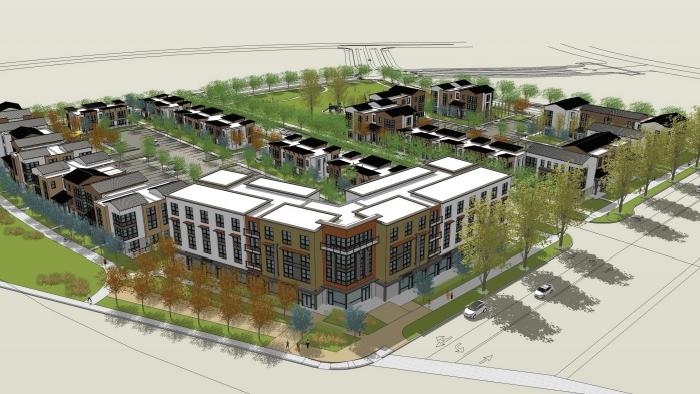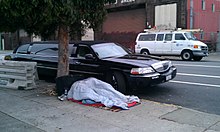
Twin Rivers redevelopment project. (Photo: SHRA)
California’s Unaffordable “Affordable” Housing Scandal
Journalists reporting on the issue don’t spend enough time questioning the numbers
By Edward Ring, April 18, 2019 7:23 am
When discussing the seemingly intractable and growing problem of homeless people living in California, journalists reporting on the issue don’t spend enough time questioning the numbers, much less the policies driving the insane numbers. A recent article in the San Jose Mercury provides a perfect example.
The article gets off to a good start with a provocative, and very informative title. “How much would it cost to house the Bay Area’s homeless? Try $12.7 billion.” Then paragraph two leads off with another bit of vital quantitative information, “With 28,200 homeless residents, the nine-county Bay Area has the fifth-highest concentration of homelessness in the country.”

Ten paragraphs down, the problem is revealed, but not questioned: “By one metric, it would cost $12.7 billion to solve the problem. That’s the price tag to build a new unit of permanent housing for each of the 28,200 residents reported as homeless in the Bay Area in 2017, according to the report. The calculation assumes mid-range construction costs of $450,000 per unit.”
Questions should abound. Four hundred and fifty thousand dollars per person? Why is only one person going to live in each of these subsidized units? And why does a housing unit have to cost nearly a half-million dollars? You can buy a ridiculously overpriced four bedroom home in San Jose for under a million dollars, but you can’t build a studio apartment for less than a half-million? Why?
This isn’t an isolated example. The same problem exists in Los Angeles County, where the average per unit costs for “permanent supportive housing” for homeless people is also around a half-million. As reported by NPR, “The PATH Ventures project in East Hollywood has an estimated per-unit cost of $440,000. Even with real estate prices soaring, that’s as much as a single-family home in many places in Southern California. Other HHH projects cost more than $500,000 a unit.”
This is a scam, disguised as compassion.
Developers accept public money to build these projects. Cities and counties collect outrageous building fees. The buildings are then handed off to nonprofits with long term contracts to run them. Politicians accept campaign contributions from the developers and the nonprofits. Where are the journalists? Where is the withering criticism? Why isn’t this a scandal?
Why is the national average construction cost per new apartment unit somewhere between $65,000 and $85,000, yet it costs five to 10 times that much in Los Angeles and Santa Clara counties? Why do we accept this?

Earlier this week, Sue Frost, a Sacramento County Supervisor, spoke about California’s housing crisis to a taxpayers group. Her litany of reasons why housing is so expensive, and why the related problem of homelessness is so intractable, was comprehensive and depressing. It ranged from extreme environmentalist mandates such as the California Environmental Quality Act, to absurdly high fees for building permits (often equal in cost to the value of the materials used in construction), to unchecked immigration, to restrictive zoning, to numerous court orders. Even as Frost limited her remarks to summary bullet points, it took several minutes for her to recite all the causes. But in every case, it was government policies that created this nightmare, and in every case, they were policies largely unique to California.
How to Waste Taxpayer Funds
One of the “creative” solutions Sacramento County has adopted to increase the supply of housing is to streamline the process for homeowners to build “accessory dwelling units” in their backyards. At the same time, Sacramento County is funding the conversion of homes in residential neighborhoods into group homes for homeless people.
All of this sounds wonderful. But it is the path of least resistance, adopted in lieu of making fundamental reforms either through legislation or litigation. This path of least resistance means cities and counties will waste billions on new “affordable” housing for low income and homeless people. At a half-million per unit, however, spending billions will not even make a dent in the homeless population, even as it enriches developers, well-heeled nonprofits, and the campaign coffers of compliant local politicians.
Then, since those billions are wasted, they will seed residential neighborhoods with subsidized group homes for a homeless population that is, according Supervisor Frost, 50 percent mentally ill and 30 percent criminal. These group homes are run by private entrepreneurs who are, in effect, state sanctioned predators that destroy peaceful residential streets. They become inordinately enriched by cramming people into these group homes and collecting reimbursement from the government.
Similarly, Sacramento County’s supervisors have implemented an aggressive interpretation of a new state law designed to streamline the process for homeowners to build accessory dwelling units (“ADUs”) on their properties. There is nothing “accessory” about many of these new ADUs. Often they are full size homes, with their own garage, driveway, utilities, and address. All too frequently, ADU ordinances, for all practical purposes, subdivide a property in violation of zoning laws that residents relied on when they bought their homes. Equally problematic, because these lots are not actually, legally subdivided, both homes on the properties become permanent rentals.
This is happening all over the state. In Southern California, Los Angeles County has launched a program to pay homeowners to build granny flats for the homeless in their backyards. Consider the unintended consequences: Once two or more units are permitted on lots that were previously restricted to single family dwellings, these properties become worth more if they’re converted to permanent, government subsidized rentals.
Remember the “blockbusting” of the 1960s and 1970s? That was an ugly affair. Expect the same displacement in the 2020s, except it will be entirely legal. And this time, as private investors and their accomplices in real estate and the government bureaucracy convert entire residential neighborhoods into multi-family lots, they will receive government subsidies to do the conversion, then the government will pay them again to subsidize the rent they collect as landlords.
To recap: Billions are wasted constructing a handful of ridiculously expensive new housing units, then, since that makes no difference whatsoever, established residential neighborhoods are destabilized and ultimately destroyed thanks to laws enabling opportunistic investors, cashing in on government subsidies, to convert random homes into halfway houses, homeless shelters, and subdivide properties with ADUs. Nobody is safe. Welcome to California in the 2020s.
None of this is a moral choice. It disrespects the residents of these neighborhoods who have worked hard their entire lives to pay for the privilege of living a safe and tranquil environment. Moreover, these residents who are betrayed in this manner have worked far harder than they should have had to (to pay their mortgages) because of California’s state and local government policies which are to the primary cause of overpriced housing.
If a majority of local elected officials in just one major city or county in California mustered the courage to challenge the laws that have needlessly caused California’s housing shortage and homeless crisis, and litigated all the way to the U.S. Supreme Court, they could overturn some of these laws, in order to pursue far more cost effective options.
Housing Solution
For example, for the homeless, here is an alternative that could cost-effectively solve the entire problem within months, not years or decades: You can house homeless people in durable $399 10-foot-by-10-foot tents, sleeping on durable $75 cots, four per tent. You can position $649 porta potties to service these tent dwellers, and you can set up a larger tent to serve as a food kitchen and medical station. You could put these tent cities on city owned property or leased private land on the outskirts of town or in industrial areas, and by enforcing revitalized (through court action) vagrancy laws, you could swiftly move the homeless into these managed camps. You could have three types of camps, one for criminals, one for substance abusers, and one for everyone else.
More Solutions
To increase the supply of housing, the solution is harder, but obviously possible, since so many other states in America do not have housing shortages. Policies to make housing affordable again in California could be accomplished without requiring expensive government programs. Instead, to name a few policy changes: lower the fees for building permits, speed up the permitting process, reform extreme environmental regulations, make it easier to extract building materials in-state, and, crucially, end the policies of “urban containment” that deny building permits on California’s vast expanses of open land.
It is time for a courageous city council or county board of supervisors somewhere in California to pursue, through litigation, cost-effective, practical solutions that don’t ruin the lives of the many for the sake of the few. Particularly since government policies are the reason the many have to work so hard. And if mainstream journalists would abandon their politically correct group-think, and question the status-quo with the skepticism that once was the life blood of their profession, public awareness might demand such action.
- Ringside: Quantifying California’s Brave EV Future - July 25, 2024
- Ringside: California’s Water Economy – The Three Biggest Choices - July 18, 2024
- Ringside: An Overview of California’s Water Economy - July 13, 2024





“… reform extreme environmental regulations, make it easier to extract building materials in-state, and, crucially, end the policies of “urban containment” that deny building permits on California’s vast expanses of open land.”
Well, you had me until I got to the above quote. Really????You want to trash up the little remaining, precious open space out there to deal with the homeless problem? From my vantage point, “urban containment” is a godsend. And there’s nothing “extreme” about California’ environmental regulations. They’re the only things that stand between “livability” for the rest of us and construction/building/paving/tree-trashing run amok. Why IS it every think tank’s answer to urban problems is to turn every community into (Goddess help us) Orange County? That’s certainly not a place I want to call home.
Carol,
Thank you for your comment. I must respectfully take issue, however, with most of your assertions.
You write “you want to trash up the little remaining, precious open space out there to deal with the homeless problem.” How can you possibly think there is “little remaining, precious open space” in California? The state is only five percent urbanized, and has an area of 164,000 square miles. There are 25,000 square miles just of cattle rangeland, much of which is being taken out of production. Why not build homes on some of it? As I’ve stated, and the facts are indisputable, you could put ten million people onto homes on half-acre lots (only three people per home) and even allowing for an equal amount of space for roads and industrial/retail areas, you would only use up 5,200 square miles. That’s only around 2.5 percent of California’s land area, and it is unimaginable that such a low density scenario would ever happen.
As for extracting building materials in-state, such as aggregate and lumber, don’t you think it’s a bit hypocritical to source all of this from other places? And what about the raw materials needed for all those massive stationary storage batteries, or mobile electric and hybrid car batteries, and solar panels? Don’t you think some other place is being “trashed” so we can import all that? Wouldn’t we do it more responsibly if we mined all that stuff here, instead of somewhere in Africa or Asia?
You don’t want to live in Orange County, or, apparently, anywhere else in urban California? Where do you live? Do you understand that as California’s state legislature rolls out the welcome mat for every potential foreign expatriate on earth, they want to cram those millions of newcomers into housing, often subsidized, within existing cities? Do you think your city is safe from this? This is completely unnecessary. There is plenty of land in California, and piling additional millions on top of the millions already living in our cities, based on the falsehood that we are running out of open space, is wrong on many levels. It enriches only the wealthiest politically connected developers, it creates a property bubble that’s good for property tax revenue and real estate speculators, it crams people into existing cities, also raising property taxes, it denies people who want a bit of open space (a yard, a pool) the opportunity to have that, and it pushes the price of housing to unaffordable levels.
Most of the arguments against land development in California are emotional, not based on facts, logic, or fairness. “Goddess help us” indeed.
That was an informative, well thought and fact checked article. The best I have read in a long time. Thank you for your honest reporting.
Absolutely spot on my friend. Amen amen. Best I have read on this topic for a longtime. You should have this turned into a documentary. I reside in Stockton and see the mess constantly. We have a mayor that would likely hear your thoughts. Not so sure about city council or county level but maybe worth making contact. I do know that Mayor Lincoln studied how locations such as San Diego has dealt with it. We currently have a soon to retire police chief who is a very weak on things And hopefully will be replaced with somebody that can be a bit tougher. Actually much tougher. I fight it daily here to the point of having a gun pulled on me and all kinds of stuff. Crazy enough, same guy making that threat, shot and killed a guy about 50 ft away from me just a few weeks later. Not that I hang out with them. I was inside my parking lot working on a vehicle when the murder happened. And its ALL related. Homelessness, drugs, death from overdose or deals going bad. I know just by being aware. Its literally insanity the way they “handle” the crises. So so corrupt.
I believe or county sheriff is strong on this subject. So maybe a few courageous people can be found here. I may share your perfect article with the mayor.
GOD help us. Blessings…